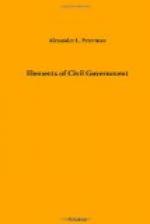UNITED STATES CIRCUIT COURTS OF APPEALS.—Each United States circuit embraces several States, and has two or more circuit judges. One justice of the Supreme Court is also assigned to each circuit. There are nine circuit courts of appeals, one for each United States circuit. All appeals from the district courts must be made to the circuit courts of appeals, except in cases expressly provided by law to be taken direct to the Supreme Court; but provision is also made for appeal from the decision of the circuit courts of appeals to the Supreme Court in certain classes of cases.
UNITED STATES DISTRICT COURT.—Each State has one or more United States district courts, each presided over by a district judge. The district court has both civil and criminal jurisdiction in all cases under the national law which are not required to be brought in other courts. Before 1912 there were so-called “circuit courts” usually held by the district judges, for the trial of certain important kinds of cases; but these were abolished by an act of 1911.
In each State a large majority of the civil and criminal cases must be tried and finally decided in the State courts. However, among the important cases tried in United States courts are those concerning patents, copyrights, and bankruptcy, those involved in the regulation of interstate and foreign commerce, and offenses committed against the postal and revenue laws.
Interstate commerce cases are often in the form of appeals from the orders issued by the interstate commerce commission, fixing the freight and passenger rates of railroads, etc. Such a case is heard by three judges sitting together, and an appeal from their decision can be taken directly to the Supreme Court.
If the circuit and district judges desire, they may retire upon full pay at the age of seventy, after ten years of consecutive service.
COURT OF CUSTOMS APPEALS.—The customs court consists of a chief judge and four associate judges. It decides disputes over the rates of duty payable on imported goods. It holds sessions both at Washington and in other cities.
COURT OF CLAIMS.—The court of claims holds its sessions at Washington, and consists of a chief justice and four associate justices. It hears and determines claims against the United States. No one could bring suit against the national government without permission from Congress; but a person having a claim against it may submit the claim to the court of claims for trial, and, if the claim is declared to be legal and just, it is almost always paid by act of Congress.
OTHER COURTS.—The District of Columbia has six supreme court justices and three justices of a court of appeals. Their jurisdiction is similar to that of the United States district courts and circuit courts of appeals, but is confined to the District of Columbia.
Territorial courts consist of a chief justice and two associate justices, who hold their offices for a term of four years, unless removed by the President. A territorial court holds its sessions in the Territory for which it is constituted, and has jurisdiction of cases arising under the laws of Congress and the laws passed by the territorial legislature.




